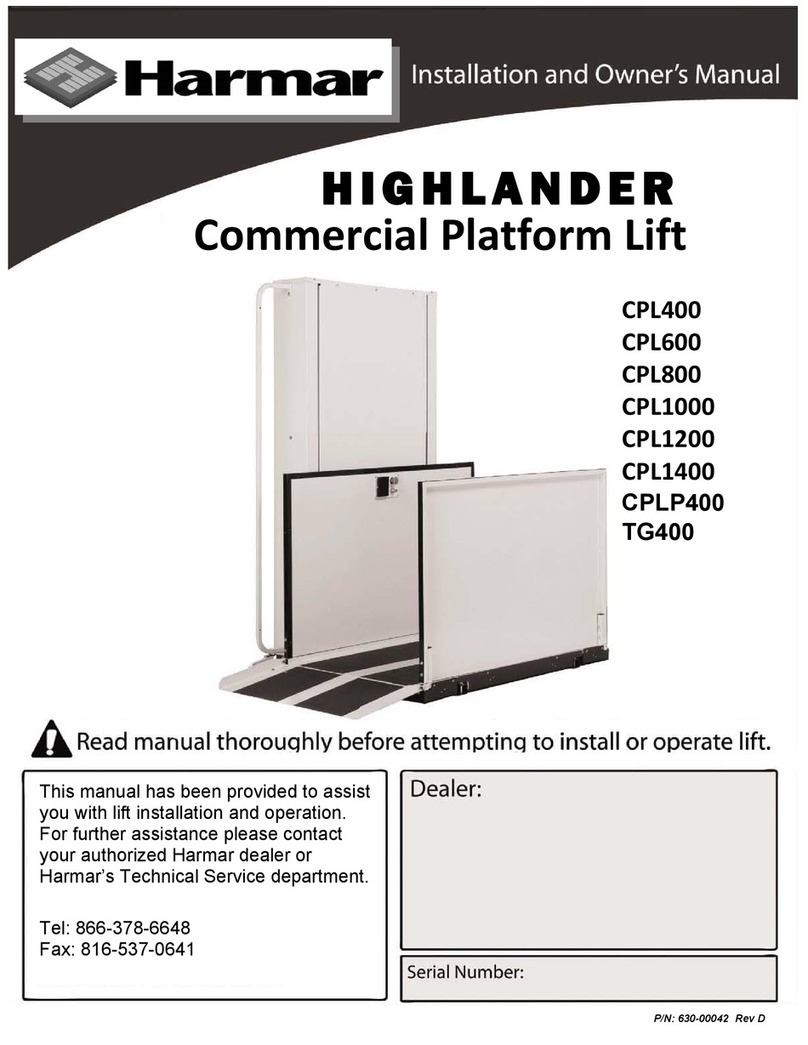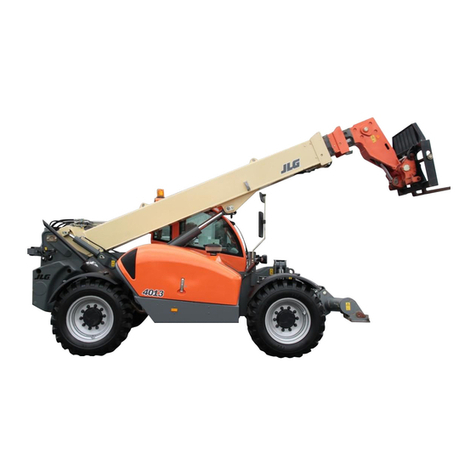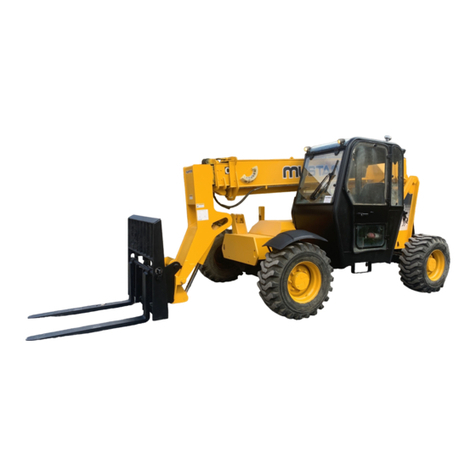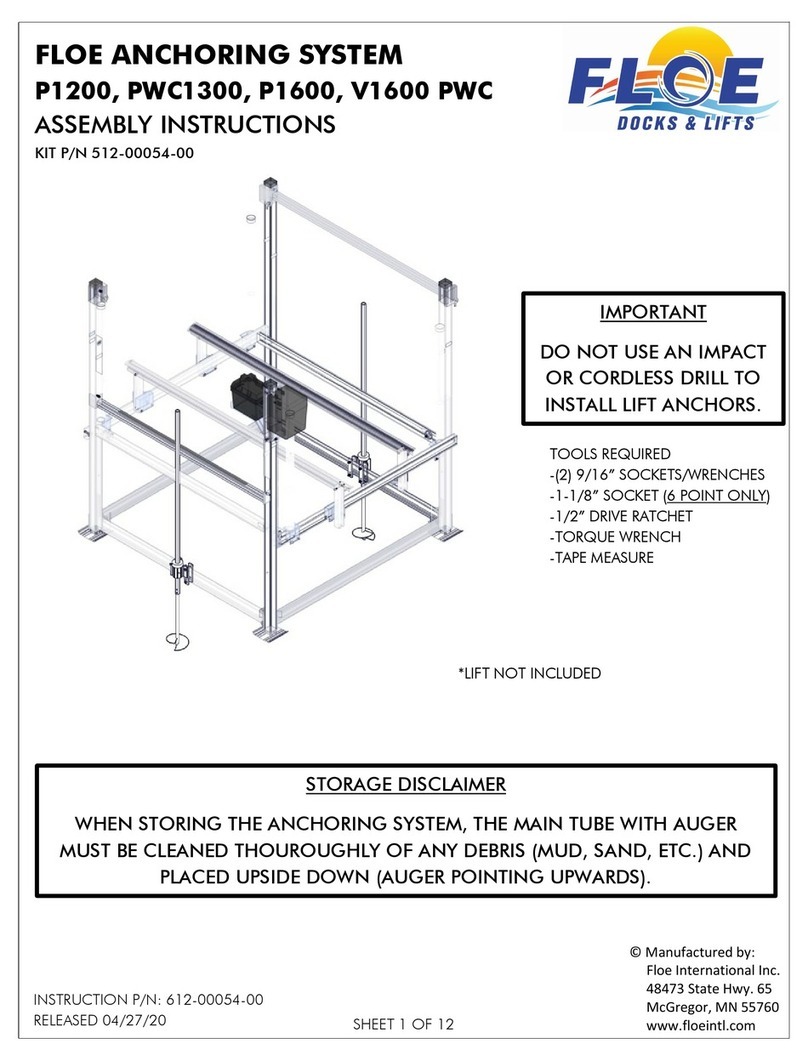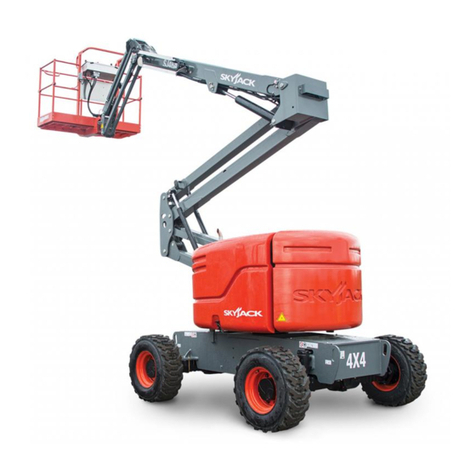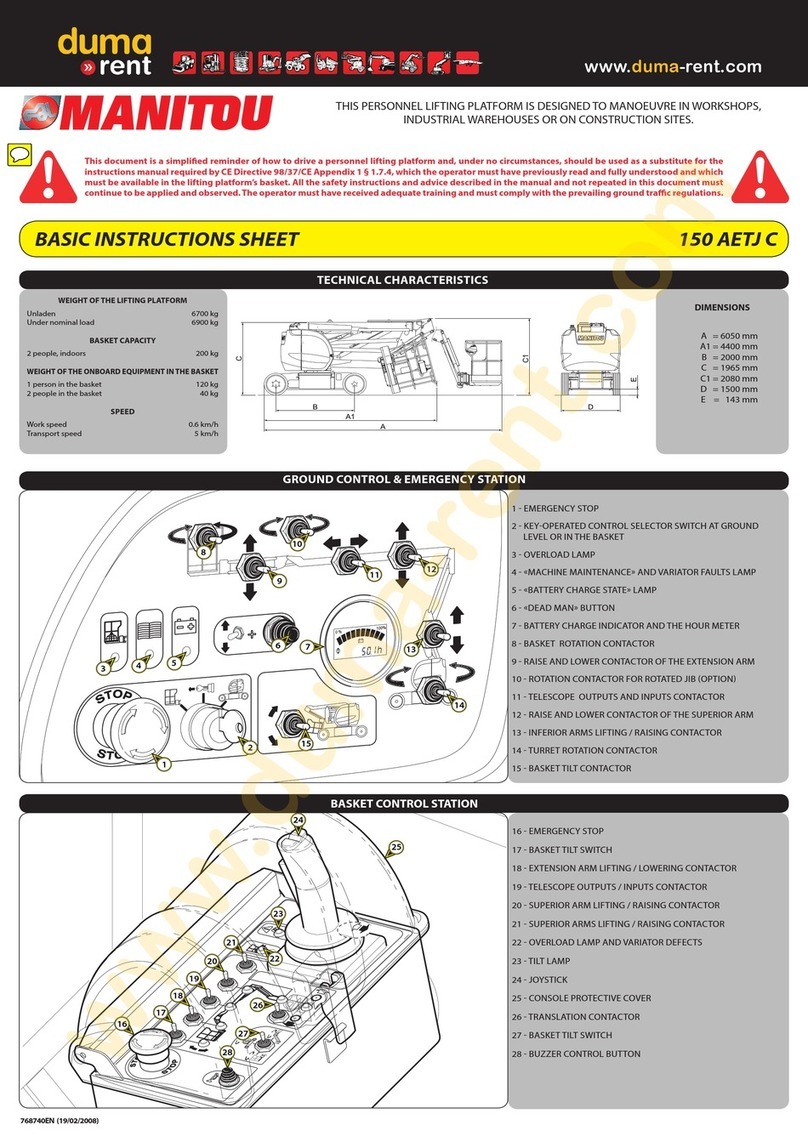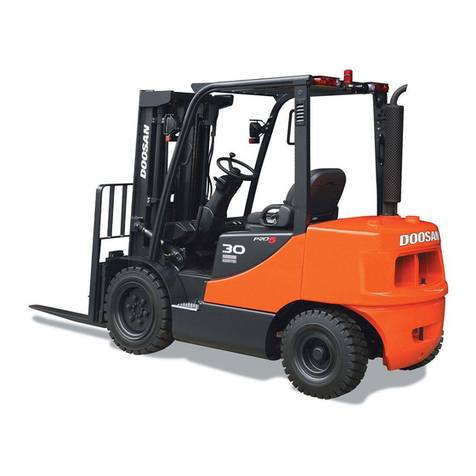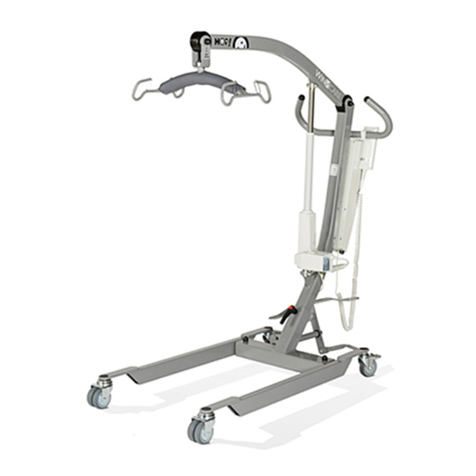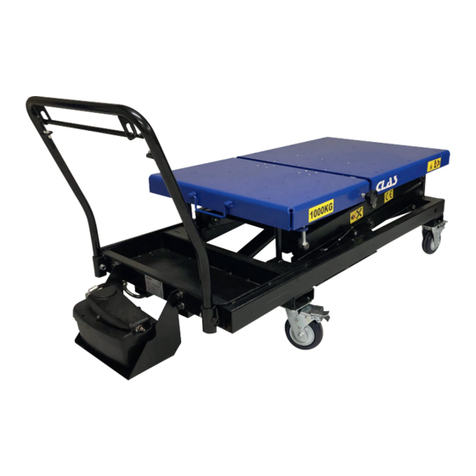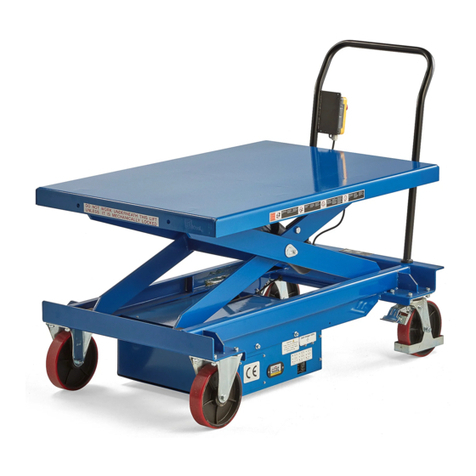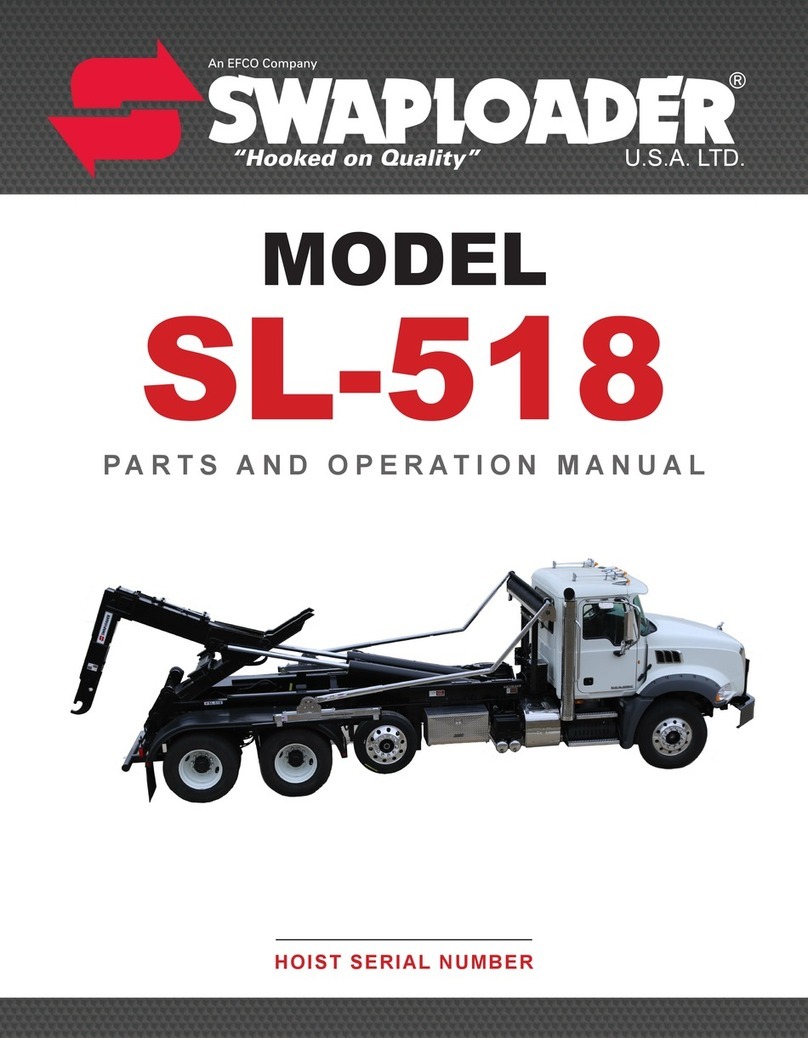Instron 5980 Series Installation instructions

5980 Series Dual Column Floor Frames
System Support M10-16250-EN Revision J
The difference is measurable
®

Electromagnetic Compatibility
Where applicable, this equipment is designed to comply with International Electromagnetic Compat-
ibility (EMC) standards.
To ensure reproduction of this EMC performance, connect this equipment to a low impedance ground
connection. Typical suitable connections are a ground spike or the steel frame of a building.
Proprietary Rights Notice
This document and the information that it contains are the property of Illinois Tool Works Inc.
(ITW). Rights to duplicate or otherwise copy this document and rights to disclose the document and
the information that it contains to others and the right to use the information contained therein may be
acquired only by written permission signed by a duly authorized officer of ITW.
Trademarks
Instron®is a registered trademark of Illinois Tool Works Inc (ITW). Other names, logos, icons, and
marks identifying Instron products and services referenced herein are trademarks of ITW and may
not be used without the prior written permission of ITW.
Other product and company names used herein are trademarks or trade names of their respective
companies.
Original Instructions
© Copyright 2009 Illinois Tool Works Inc. All rights reserved. All of the specifications shown
in this document are subject to change without notice.
Worldwide Headquarters
Instron
825 University Avenue
Norwood, MA 02062-2643
United States of America
European Headquarters
Instron
Coronation Road
High Wycombe, Bucks HP12 3SY
United Kingdom

iii
Preliminary Pages
Product Support: www.instron.com
General Safety Precautions
Materials testing systems are potentially hazardous.
Materials testing involves inherent hazards from high forces, rapid motions, and stored
energy. You must be aware of all moving and operating components in the testing
system that are potentially hazardous, particularly force actuators or a moving
crosshead.
Carefully read all relevant manuals and observe all Warnings and Cautions. The term
Warning is used where a hazard may lead to injury or death. The term Caution is used
where a hazard may lead to damage to equipment or to loss of data.
Instron products, to the best of its knowledge, comply with various national and
international safety standards, in as much as they apply to materials and structural
testing. We certify that our products comply with all relevant EU directives (CE mark).
Because of the wide range of applications with which our instruments are used, and over
which we have no control, additional protection devices and operating procedures may
be necessary due to specific accident prevention regulations, safety regulations, further
EEA directives or locally valid regulations. The extent of our delivery regarding
protective devices is defined in your initial sales quotation. We are thus free of liability
in this respect.
At your request, we will gladly provide advice and quotations for additional safety
devices such as protective shielding, warning signs or methods of restricting access to
the equipment.
The following pages detail various general warnings that you must heed at all times
while using materials testing equipment. You will find more specific Warnings and
Cautions in the text whenever a potential hazard exists.
Your best safety precautions are to gain a thorough understanding of the equipment by
reading your instruction manuals and to always use good judgement.
It is our strong recommendation that you should carry out your own safety risk
assessment on the use of the test system, test methods employed, specimen loading and
specimen behavior at failure.

Preliminary Pages
iv M10-16250-EN
Warnings
Crush Hazard - Allow only one person to handle or operate the system at all times.
Operator injury may result if more than one person operates the system. Before working
inside the hazard area between the grips or fixtures, ensure that no other personnel can
operate the computer or any of the system controls.
Crush Hazard - Take care when installing or removing a specimen, assembly,
structure, or load string component.
Installation or removal of a specimen, assembly, structure, or load string component
involves working inside the hazard area between the grips or fixtures. Keep clear of the
jaws of a grip or fixture at all times. Keep clear of the hazard area between the grips or
fixtures during actuator or crosshead movement. Ensure that all actuator or crosshead
movements necessary for installation or removal are slow and, where possible, at a low
force setting.
Hazard - Press the Emergency Stop button whenever you consider that an unsafe
condition exists.
The Emergency Stop button removes hydraulic power or electrical drive from the testing
system and brings the hazardous elements of the system to a stop as quickly as possible.
It does not isolate the system from electrical power, other means are provided to
disconnect the electrical supply. Whenever you consider that safety may be
compromised, stop the test using the Emergency Stop button. Investigate and resolve the
situation that caused the use of the Emergency Stop button before you reset it.
Flying Debris Hazard - Make sure that test specimens are installed correctly in
grips or fixtures in order to eliminate stresses that can cause breakage of grip
jaws or fixture components.
Incorrect installation of test specimens creates stresses in grip jaws or fixture components
that can result in breakage of these components. The high energies involved can cause
the broken parts to be projected forcefully some distance from the test area. Install
specimens in the center of the grip jaws in line with the load path. Insert specimens into
the jaws by at least the amount recommended in your grip documentation. This amount
can vary between 66% to 100% insertion depth; refer to supplied instructions for your
specific grips. Use any centering and alignment devices provided.
Hazard - Protect electrical cables from damage and inadvertent disconnection.
The loss of controlling and feedback signals that can result from a disconnected or
damaged cable causes an open loop condition that may drive the actuator or crosshead
rapidly to its extremes of motion. Protect all electrical cables, particularly transducer
cables, from damage. Never route cables across the floor without protection, nor suspend
cables overhead under excessive strain. Use padding to avoid chafing where cables are
routed around corners or through wall openings.

v
Preliminary Pages
Product Support: www.instron.com
High/Low Temperature Hazard - Wear protective clothing when handling
equipment at extremes of temperature.
Materials testing is often carried out at non-ambient temperatures using ovens, furnaces
or cryogenic chambers. Extreme temperature means an operating temperature exceeding
60 °C (140 °F) or below 0 °C (32 °F). You must use protective clothing, such as gloves,
when handling equipment at these temperatures. Display a warning notice concerning
low or high temperature operation whenever temperature control equipment is in use.
You should note that the hazard from extreme temperature can extend beyond the
immediate area of the test.
Hazard - Do not place a testing system off-line from computer control without first
ensuring that no actuator or crosshead movement will occur upon transfer to
manual control.
The actuator or crosshead will immediately respond to manual control settings when the
system is placed off-line from computer control. Before transferring to manual control,
make sure that the control settings are such that unexpected actuator or crosshead
movement cannot occur.
Robotic Motion Hazard - Keep clear of the operating envelope of a robotic device
unless the device is de-activated.
The robot in an automated testing system presents a hazard because its movements are
hard to predict. The robot can go instantly from a waiting state to high speed operation in
several axes of motion. During system operation, keep away from the operating envelope
of the robot. De-activate the robot before entering the envelope for any purpose, such as
reloading the specimen magazine.
Hazard - Set the appropriate limits before performing loop tuning or running
waveforms or tests.
Operational limits are included within your testing system to suspend motion or shut off
the system when upper and/or lower bounds of actuator or crosshead travel, or force or
strain, are reached during testing. Correct setting of operational limits by the operator,
prior to testing, will reduce the risk of damage to test article and system and associated
hazard to the operator.
Electrical Hazard - Disconnect the electrical power supply before removing the
covers to electrical equipment.
Disconnect equipment from the electrical power supply before removing any electrical
safety covers or replacing fuses. Do not reconnect the power source while the covers are
removed. Refit covers as soon as possible.
Warnings

Preliminary Pages
vi M10-16250-EN
Rotating Machinery Hazard - Disconnect power supplies before removing the
covers to rotating machinery.
Disconnect equipment from all power supplies before removing any cover which gives
access to rotating machinery. Do not reconnect any power supply while the covers are
removed unless you are specifically instructed to do so in the manual. If the equipment
needs to be operated to perform maintenance tasks with the covers removed, ensure that
all loose clothing, long hair, etc. is tied back. Refit covers as soon as possible.
Hazard - Shut down the hydraulic power supply and discharge hydraulic pressure
before disconnection of any hydraulic fluid coupling.
Do not disconnect any hydraulic coupling without first shutting down the hydraulic
power supply and discharging stored pressure to zero. Tie down or otherwise secure all
pressurized hoses to prevent movement during system operation and to prevent the hose
from whipping about in the event of a rupture.
Hazard - Shut off the supply of compressed gas and discharge residual gas
pressure before you disconnect any compressed gas coupling.
Do not release gas connections without first disconnecting the gas supply and
discharging any residual pressure to zero.
Explosion Hazard - Wear eye protection and use protective shields or screens
whenever any possibility exists of a hazard from the failure of a specimen,
assembly or structure under test.
Wear eye protection and use protective shields or screens whenever a risk of injury to
operators and observers exists from the failure of a test specimen, assembly or structure,
particularly where explosive disintegration may occur. Due to the wide range of
specimen materials, assemblies or structures that may be tested, any hazard resulting
from the failure of a test specimen, assembly or structure is entirely the responsibility of
the owner and the user of the equipment.
Hazard - Ensure components of the load string are correctly pre-loaded to
minimize the risk of fatigue failure.
Dynamic systems, especially where load reversals through zero are occurring, are at risk
of fatigue cracks developing if components of the load string are not correctly pre-loaded
to one another. Apply the specified torque to all load string fasteners and the correct
setting to wedge washers or spiral washers. Visually inspect highly stressed components
such as grips and threaded adapters prior to every fatigue test for signs of wear or fatigue
damage.
Warnings

vii
Preliminary Pages
Product Support: www.instron.com
Table of Contents
Chapter 1 Introduction . . . . . . . . . . . . . . . . . . . . . . . . . . . . . . . . . . . . . . . . . . . . . . . 1-1
System Description and Terminology. . . . . . . . . . . . . . . . . . . . . . . . . . . . . . . . . . . . 1-2
Components . . . . . . . . . . . . . . . . . . . . . . . . . . . . . . . . . . . . . . . . . . . . . . . . . . . 1-3
Principle of Operation . . . . . . . . . . . . . . . . . . . . . . . . . . . . . . . . . . . . . . . . . . . . 1-4
Hardware Controls . . . . . . . . . . . . . . . . . . . . . . . . . . . . . . . . . . . . . . . . . . . . . . 1-5
Software . . . . . . . . . . . . . . . . . . . . . . . . . . . . . . . . . . . . . . . . . . . . . . . . . . . . . . 1-5
System Components and Interconnections . . . . . . . . . . . . . . . . . . . . . . . . . . . . . . . 1-6
System Safety and Information Labeling . . . . . . . . . . . . . . . . . . . . . . . . . . . . . . . . . 1-8
Product Support. . . . . . . . . . . . . . . . . . . . . . . . . . . . . . . . . . . . . . . . . . . . . . . . . . . 1-10
Product Documentation . . . . . . . . . . . . . . . . . . . . . . . . . . . . . . . . . . . . . . . . . . . . . 1-10
Chapter 2 Requirements and Specifications . . . . . . . . . . . . . . . . . . . . . . . . . . . . . 2-1
Responsibilities . . . . . . . . . . . . . . . . . . . . . . . . . . . . . . . . . . . . . . . . . . . . . . . . . . . . 2-1
Customer’s Responsibilities . . . . . . . . . . . . . . . . . . . . . . . . . . . . . . . . . . . . . . . 2-1
Instron’s Responsibilities . . . . . . . . . . . . . . . . . . . . . . . . . . . . . . . . . . . . . . . . . 2-2
Site Requirements . . . . . . . . . . . . . . . . . . . . . . . . . . . . . . . . . . . . . . . . . . . . . . . . . . 2-4
Frame Location. . . . . . . . . . . . . . . . . . . . . . . . . . . . . . . . . . . . . . . . . . . . . . . . . 2-4
Floor Loading . . . . . . . . . . . . . . . . . . . . . . . . . . . . . . . . . . . . . . . . . . . . . . . . . . 2-4
Table Loading . . . . . . . . . . . . . . . . . . . . . . . . . . . . . . . . . . . . . . . . . . . . . . . . . . 2-4
Power Supply . . . . . . . . . . . . . . . . . . . . . . . . . . . . . . . . . . . . . . . . . . . . . . . . . . 2-4
Telephone and Network Access . . . . . . . . . . . . . . . . . . . . . . . . . . . . . . . . . . . . 2-5
Ceiling Clearance . . . . . . . . . . . . . . . . . . . . . . . . . . . . . . . . . . . . . . . . . . . . . . . 2-5
Environmental Conditions. . . . . . . . . . . . . . . . . . . . . . . . . . . . . . . . . . . . . . . . . 2-5
Accessibility . . . . . . . . . . . . . . . . . . . . . . . . . . . . . . . . . . . . . . . . . . . . . . . . . . . 2-5
Site Requirements for System Accessories . . . . . . . . . . . . . . . . . . . . . . . . . . . 2-6
Environmental Specifications . . . . . . . . . . . . . . . . . . . . . . . . . . . . . . . . . . . . . . . . . . 2-7
General . . . . . . . . . . . . . . . . . . . . . . . . . . . . . . . . . . . . . . . . . . . . . . . . . . . . . . . 2-7
Conformity with EU directives. . . . . . . . . . . . . . . . . . . . . . . . . . . . . . . . . . . . . . 2-7
Environmental Impact . . . . . . . . . . . . . . . . . . . . . . . . . . . . . . . . . . . . . . . . . . . . 2-7
Noise Levels . . . . . . . . . . . . . . . . . . . . . . . . . . . . . . . . . . . . . . . . . . . . . . . . . . . 2-8
Power Requirements . . . . . . . . . . . . . . . . . . . . . . . . . . . . . . . . . . . . . . . . . . . . . . . . 2-8

Preliminary Pages
viii M10-16250-EN
Power Cord Selections . . . . . . . . . . . . . . . . . . . . . . . . . . . . . . . . . . . . . . . . . . . . . . 2-9
Series 5980 Optional Configurations . . . . . . . . . . . . . . . . . . . . . . . . . . . . . . . . . . . 2-11
5982, 5984 and 5985 Dimensions . . . . . . . . . . . . . . . . . . . . . . . . . . . . . . . . . . . . . 2-11
Standard, Extra Height and Extra Wide Options. . . . . . . . . . . . . . . . . . . . . . . 2-11
Second Test Space Options . . . . . . . . . . . . . . . . . . . . . . . . . . . . . . . . . . . . . . 2-14
5988 and 5989 Dimensions . . . . . . . . . . . . . . . . . . . . . . . . . . . . . . . . . . . . . . . . . . 2-16
Load Frame Weights . . . . . . . . . . . . . . . . . . . . . . . . . . . . . . . . . . . . . . . . . . . . . . . 2-17
Accessory Mounting Dimensions. . . . . . . . . . . . . . . . . . . . . . . . . . . . . . . . . . . . . . 2-19
Checklist for Site Preparation . . . . . . . . . . . . . . . . . . . . . . . . . . . . . . . . . . . . . . . . 2-28
Site Location . . . . . . . . . . . . . . . . . . . . . . . . . . . . . . . . . . . . . . . . . . . . . . . . . . 2-28
Transporting . . . . . . . . . . . . . . . . . . . . . . . . . . . . . . . . . . . . . . . . . . . . . . . . . . 2-28
Scheduling Installation . . . . . . . . . . . . . . . . . . . . . . . . . . . . . . . . . . . . . . . . . . 2-29
Chapter 3 Lifting and Handling . . . . . . . . . . . . . . . . . . . . . . . . . . . . . . . . . . . . . . . . 3-1
General Handling Precautions. . . . . . . . . . . . . . . . . . . . . . . . . . . . . . . . . . . . . . . . . 3-1
Packaging Dimensions . . . . . . . . . . . . . . . . . . . . . . . . . . . . . . . . . . . . . . . . . . . . . . 3-2
Unpacking Dual Column Frames . . . . . . . . . . . . . . . . . . . . . . . . . . . . . . . . . . . . . . . 3-3
Righting the Frame from a Prone Position. . . . . . . . . . . . . . . . . . . . . . . . . . . . . . . . 3-4
Using a Crane. . . . . . . . . . . . . . . . . . . . . . . . . . . . . . . . . . . . . . . . . . . . . . . . . . 3-5
Using a Forklift . . . . . . . . . . . . . . . . . . . . . . . . . . . . . . . . . . . . . . . . . . . . . . . . . 3-6
Transporting Dual Column Frames . . . . . . . . . . . . . . . . . . . . . . . . . . . . . . . . . . . . . 3-8
Before You Begin . . . . . . . . . . . . . . . . . . . . . . . . . . . . . . . . . . . . . . . . . . . . . . . 3-8
Equipment. . . . . . . . . . . . . . . . . . . . . . . . . . . . . . . . . . . . . . . . . . . . . . . . . . . . . 3-9
Transporting Procedures . . . . . . . . . . . . . . . . . . . . . . . . . . . . . . . . . . . . . . . . . 3-9
Chapter 4 Installation . . . . . . . . . . . . . . . . . . . . . . . . . . . . . . . . . . . . . . . . . . . . . . . . 4-1
Level the Load Frame . . . . . . . . . . . . . . . . . . . . . . . . . . . . . . . . . . . . . . . . . . . . . . . 4-1
Equipment. . . . . . . . . . . . . . . . . . . . . . . . . . . . . . . . . . . . . . . . . . . . . . . . . . . . . 4-1
Procedure for 5982, 5984 and 5985 Load Frames. . . . . . . . . . . . . . . . . . . . . . 4-1
Procedure for 5988 and 5989 Load Frames. . . . . . . . . . . . . . . . . . . . . . . . . . . 4-2
Power Supply Compatibility . . . . . . . . . . . . . . . . . . . . . . . . . . . . . . . . . . . . . . . . . . . 4-3
5982, 5984 and 5985 Load Frames . . . . . . . . . . . . . . . . . . . . . . . . . . . . . . . . . 4-3
5988 and 5989 Load Frames . . . . . . . . . . . . . . . . . . . . . . . . . . . . . . . . . . . . . . 4-4
Connect the System Components . . . . . . . . . . . . . . . . . . . . . . . . . . . . . . . . . . . . . . 4-6

ix
Preliminary Pages
Product Support: www.instron.com
Connect Optional Accessories. . . . . . . . . . . . . . . . . . . . . . . . . . . . . . . . . . . . . . . . 4-11
First Time Startup. . . . . . . . . . . . . . . . . . . . . . . . . . . . . . . . . . . . . . . . . . . . . . . . . . 4-12
Chapter 5 Maintenance. . . . . . . . . . . . . . . . . . . . . . . . . . . . . . . . . . . . . . . . . . . . . . . 5-1
Preventive Maintenance . . . . . . . . . . . . . . . . . . . . . . . . . . . . . . . . . . . . . . . . . . . . . 5-1
Daily Maintenance Checks . . . . . . . . . . . . . . . . . . . . . . . . . . . . . . . . . . . . . . . . 5-2
Periodic Inspections . . . . . . . . . . . . . . . . . . . . . . . . . . . . . . . . . . . . . . . . . . . . . 5-2
Cleaning . . . . . . . . . . . . . . . . . . . . . . . . . . . . . . . . . . . . . . . . . . . . . . . . . . . . . . 5-3
Lubrication . . . . . . . . . . . . . . . . . . . . . . . . . . . . . . . . . . . . . . . . . . . . . . . . . . . . 5-3
General Maintenance Procedures . . . . . . . . . . . . . . . . . . . . . . . . . . . . . . . . . . . . . . 5-8
Test Limit Stops. . . . . . . . . . . . . . . . . . . . . . . . . . . . . . . . . . . . . . . . . . . . . . . . . 5-8
Troubleshooting for Load Cells . . . . . . . . . . . . . . . . . . . . . . . . . . . . . . . . . . . . . . . . 5-9
Spare Parts . . . . . . . . . . . . . . . . . . . . . . . . . . . . . . . . . . . . . . . . . . . . . . . . . . . . . . 5-10
Ancillary Parts - Frames with a Single Test Space . . . . . . . . . . . . . . . . . . . . . 5-10
Ancillary Parts - Frames with a Second Test Space . . . . . . . . . . . . . . . . . . . . 5-13

Preliminary Pages
xM10-16250-EN

1-1
Chapter 1
Introduction
•System Description and Terminology . . . . . . . . . . . . . . . . . . . . . . . . . . . . . . . . . . . 1-2
•System Components and Interconnections. . . . . . . . . . . . . . . . . . . . . . . . . . . . . . . . 1-6
•System Safety and Information Labeling. . . . . . . . . . . . . . . . . . . . . . . . . . . . . . . . . 1-8
•Product Support . . . . . . . . . . . . . . . . . . . . . . . . . . . . . . . . . . . . . . . . . . . . . . . . . . . 1-10
•Product Documentation . . . . . . . . . . . . . . . . . . . . . . . . . . . . . . . . . . . . . . . . . . . . . 1-10
These instructions include the following information:
•system specifications that are required for installation of your testing system, for
example required environmental conditions, system weights and dimensions
•transporting your system to its final location, including instructions for lifting and
handling
•installing and connecting all the system components together (carried out by an Instron
Service Engineer for first-time installation)
•configuring the system before you start testing (carried out by an Instron Service
Engineer for first-time installation)
•routine maintenance of the system
•spare parts
Refer to the Operator’s Guide for instructions on running tests.

Chapter: Introduction
1-2 M10-16250-EN
System Description and Terminology
Figure 1-1 on page 1-2 shows the location of components on 5982, 5984 and 5985 load
frames. The 5988 and 5989 frames are substantially the same, except for the location of the
power input and ground stud, as shown in Figure 1-2 on page 1-3.
Front View Rear View
Figure 1-1. 5982, 5984 and 5985 Dual Column Floor Frames
Frame base
Base
Base adapter
Controller
Options panel
Motor cover
Ground stud
Column
cover
T-slots Ballscrew cover
Crosshead
Top plate
Emergency stop
button
Power switch
Control
panel
beam
System ID label
(5982 only)
Upper
Limit
switch
actuator
Limit
switch
rod
limit
switch
Lower
limit
switch
Load cell
Power input

1-3
System Description and Terminology
Product Support: www.instron.com
Components
The major components of an Instron electromechanical testing system include:
•Load frame with integral controller
•Load cell mounted to the crosshead
•Grips for tension testing or table-mounted anvils on a platen for compression testing.
•Instron approved computer system with Instron Bluehill® software.
Front View Rear View
Figure 1-2. 5988 and 5989 Dual Column Floor Frames
Ground stud
Power input

Chapter: Introduction
1-4 M10-16250-EN
Special fixtures are available for applications such as flexure and peel testing. For strain
measurement, an optional strain gauge extensometer attaches to the specimen. You can use
non-contacting extensometers with specimens that are unable to support a contacting
extensometer. Contact your regional Instron office or check our web site at
www.instron.com for assistance with Instron’s grips and fixtures.
The following table defines the components of the testing system:
Principle of Operation
The system communicates primarily through the controller. The controller contains sensor
conditioning cards for the system transducers and transfers data between the transducers and
the computer. The controller also communicates with the load frame via a frame interface
Table 1-1. Testing System Components
Component Description
Load Frame The load frame comprises a base, one or two columns, a moving
crosshead, and a top plate. It is a high stiffness support structure
against which the test forces react.
Each column comprises a guide column and a ballscrew. The
crosshead is mounted on both the guide column and the ballscrew.
Rotation of the ballscrew drives the crosshead up or down while the
guide column provides stability.
Controller The hardware that controls the frame and any ancillary equipment
connected to the testing system. The controller panel contains all the
connectors for load cells, extensometers and any other sensors that
are required for testing.
Control Panel The hardware panel, mounted on the side of the load frame, that lets
you perform some of the software functions directly at the frame.
Load String Comprises all of the components that you install between the moving
crosshead and the load frame base (or fixed crosshead). Typically
this involves a load cell, a set of grips, any adapters that are required
to connect the components, and the specimen to be tested.
Typically, you mount a load cell on the crosshead, then a pair of grips
or fixtures on the load cell and frame base. The grips or fixtures
secure the specimen and when you start a test the crosshead moves
up or down applying a tensile or compressive load to the specimen.
The load cell converts this load into an electrical signal that the
software measures and displays.
Bluehill Software Instron testing software that controls the testing system, running tests
and analyzing test data to produce test results.
Specimen A single piece of material to be tested.

1-5
System Description and Terminology
Product Support: www.instron.com
board (FIB) inside the load frame. The FIB links all the electrical components of the frame
together.
Hardware Controls
The hardware controls consist of:
•Emergency stop button - to be used whenever you need to stop the crosshead
immediately because an unsafe condition exists.
•Limit stops - these must be set before each test session to protect the operator against
unexpected crosshead movement.
•Control panel - lets you perform certain functions at the frame instead of at the
computer. These include starting and stopping a test and using the jog controls to
position the crosshead prior to installing a specimen.
Software
Control of the testing system is carried out via Instron Bluehill software. Setting test
parameters, operating the system, and collecting test data is done through the software
program.
Table 1-2. Software Terminology
Term Description
Test Method In Bluehill software, a test method is a file that contains a set of
defined parameters that the system uses to run tests, analyze the test
data, and produce calculated results.
Sample A group of material specimens, whose properties are studied and
compared to gain statistical or quality assurance information. For
example, you could take a specimen from different parts of a single
manufacturing run of a material to form a sample of the material. The
sample is then representative of the complete run and you can test it
to ensure that the material quality has remained stable over the
complete run. You perform the same test on each specimen in a
sample.

Chapter: Introduction
1-6 M10-16250-EN
System Components and Interconnections
Figure 1-3 on page 1-6 and Figure 1-4 on page 1-7 show you how each hardware
component is connected to make up the complete testing system.
Figure 1-3. 5982, 5984 and 5985 System Connections
GRN/YEL - Earth
BRN - Live
BLU - Neutral
Ground stud
Load cell
Load cell connection
Controller
Supplemental ground
cable
Computer interface
connection
Load cell cable
Mains power cable
Ethernet
crossover cable
System
ID label

1-7
System Components and Interconnections
Product Support: www.instron.com
Figure 1-4. 5988 and 5989 System Connections
BLACK - Live 1
BLACK - Live 2
BLACK - Live 3
BLACK - Neutral
GRN/YEL - Earth
Ground stud
Load cell
Controller
Supplemental ground
cable
Computer interface
connection
Load cell cable
Mains power cable
Ethernet
crossover cable
System ID
label
Load cell connection

Chapter: Introduction
1-8 M10-16250-EN
System Safety and Information Labeling
Table 1-3 on page 1-8 explains the meanings of any safety and information labels that may
be attached to any part of the testing system.
Table 1-3. Safety and Information Labeling Descriptions
Label Meaning Purpose
Electrical
hazard
Indicates that an electrical hazard exists
from high voltage or electrical current.
Disconnect power
supply
Disconnect the power supply before
servicing machine.
Electrical - fuse
warning Indicates an electrical hazard exists.
Advises about disconnecting power mains
before changing fuses and using only
specified fuses.
Belt
entanglement hazard
Indicates that a hazard exists from the
drive belt and pulley system.
High
temperature hazard
Indicates that a heat hazard exists. Stay
clear of area when operating the machine.
Rotating machinery
hazard
Indicates that a rotating hazard exists.
Keep clear of these areas (and tie back
long hair).

1-9
System Safety and Information Labeling
Product Support: www.instron.com
Ground stud Indicates a ground stud.
Read the manual Read and understand the operator’s
manual before using the machine.
Crosshead direction Indicates the direction to turn the pulley to
manually move the crosshead upward.
Pulleys can be turned by hand when
power is disabled.
Crush hazard Indicates the crush hazard of the moving
crosshead and instructs the user to read
and understand the operator’s manual
before using the machine.
Waste Electrical and
Electronic Equipment
(WEEE)
In accordance with the European Union’s
WEEE directive, the crossed out wheeled
bin symbol indicates that the equipment
must be disposed of separately from other
waste at the end of its usable life. For
advice on the disposal of electrical and
electronic equipment in your country,
contact your local Instron representative.
Table 1-3. Safety and Information Labeling Descriptions (Continued)
Label Meaning Purpose
Crush hazard.
Keep clear of test
area when machine
is in motion.
Read and understand
operator's manual
before using this
machine.
!WARNING

Chapter: Introduction
1-10 M10-16250-EN
Product Support
Instron provides documentation, including manuals and online help, that can answer many
of the questions you may have. It is recommended that you review the documentation sent
with the system you purchased for possible solutions to your questions.
If you cannot find answers in these sources, contact Instron’s Service department directly. A
list of Instron offices is available on our website at www.instron.com. In the US and
Canada, you can call directly at 1-800-473-7838.
Product Documentation
Instron offers a comprehensive range of documentation to help you get the most out of your
Instron products. Depending on what you have purchased, your documentation may include
some or all of the following:
We welcome your feedback on any aspect of the product documentation. Please email
[email protected] with your comments.
Operator’s Guide How to use your system components and controls,
procedures for setting limits, calibration and other
frequently performed operating tasks.
System Support Information about system installation, set up and
configuration, transducer connection and calibration.
Online Help Software products come complete with context
sensitive help, which provides detailed information on
how to use all software features.
Accessory
Equipment Reference
How to set up and use any accessories you have
purchased, for example grips, fixtures, extensometers,
transducers, and environmental chambers.
This manual suits for next models
9
Table of contents
